As DAP professionals, it can be difficult to convey the value of what we do to our wider organization. We see the value because we live and breath it everyday, but getting others to understand that value is often harder. This is why measuring our impact is so critical.
The trouble is, not all value is as easy to measure as one would like. Here, I’ll break down, step-by-step, how to demystify DAP value using a practice used widely in retail: store walks. Plus, I’ll share a simple equation you can use to measure and prove your DAP interventions’ impact. Let’s get started!
Prefer video format? Watch me present on this topic at WalkMe Elevate 2022.
Realizing value takes time
Deriving value from your digital adoption content might seem overwhelming, and, in my experience working in this field for 5+ years, measuring value is often much harder than feeling value. This is often due to the subjective nature of where and how we apply digital adoption solutions. But, the good news? There’s a simple framework you can start using today to capture, measure, and share your DAP program’s impact.
The framework
Let’s start with a simple framework to think about how to derive value. We all are accustomed to the experience of stepping in a store, and walking through the aisles to look for a needed item. What you may not know is that there is a common practice in retail, where a store manager or team member will literally walk through the store as if they are a customer in order to gain a better understanding of the customer experience. This is called a store walk.
For example, imagine an employee putting themselves into the shoes of a customer searching for salted peanuts. The employee’s goal is to understand the ease at which the customer can find the peanuts, including how clear the signage is, how long it takes them to find the peanuts, are available staff able to help, and to identify potential friction points that could cause frustration or a bad experience overall, such as leaving the store without buying anything!
Now, apply this same framework to your digital users. We all know how frustrating it can be to work with a software that’s unfamiliar to us, or even one that’s simply non- intuitive. When it comes to DAP, store walks can help us to identify digital friction points that cause user frustration.
So, what does applying the concept of a digital store walk to DAP look like?
4 steps to success with your DAP store walk
Step 1: Capture users’ interactions with a software and identify 3-5 of the biggest pain points.
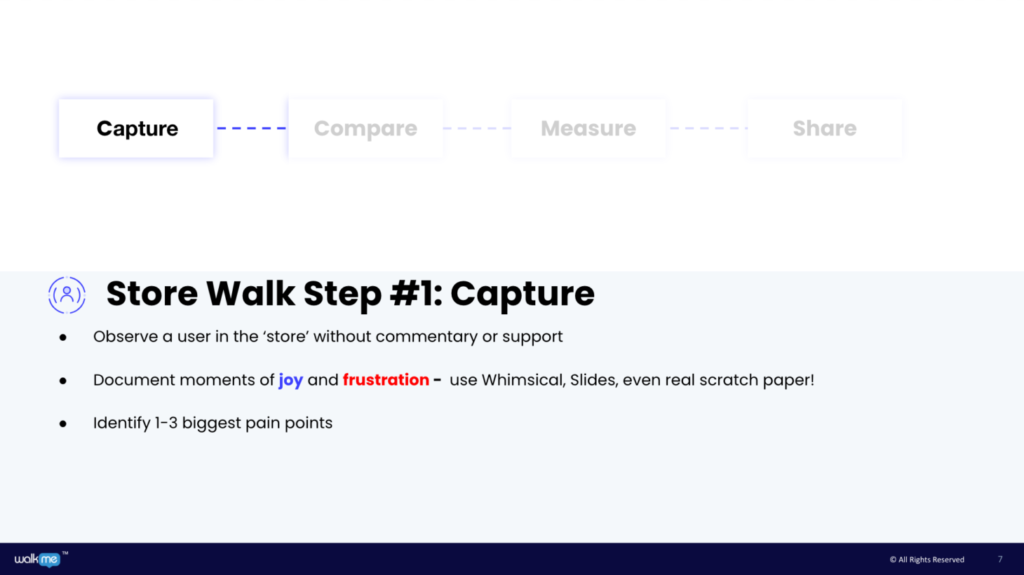
The first step of your store walk focuses on documenting users’ current behavior. In practice, this requires simply sitting with a user and observing how they use a particular system. I recommend taking notes and using a stopwatch to record how long each step of a process takes them to complete. This data will be instrumental in measuring the impact of your DAP interventions.
Step 2: Build WalkMe content to solve those top areas of frustration, and then observe the same users completing the new DAP-supported processes and the time it takes them to complete each one.
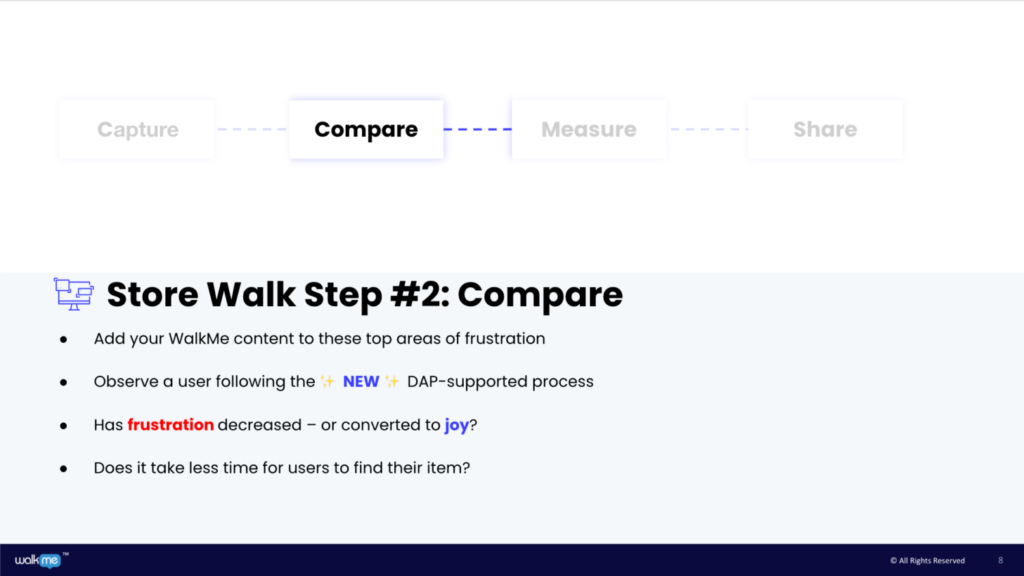
In step two, you solve the biggest friction points and observe the difference in user experience.
By implementing WalkMe content and then observing the same user again, you’ll be able to gauge the impact it has on the workflow at hand. This second run may also highlight the need for a slight alteration or addition of new content.
Step 3: Measure the difference between your baseline (original time to complete a process) and the new DAP-supported process.
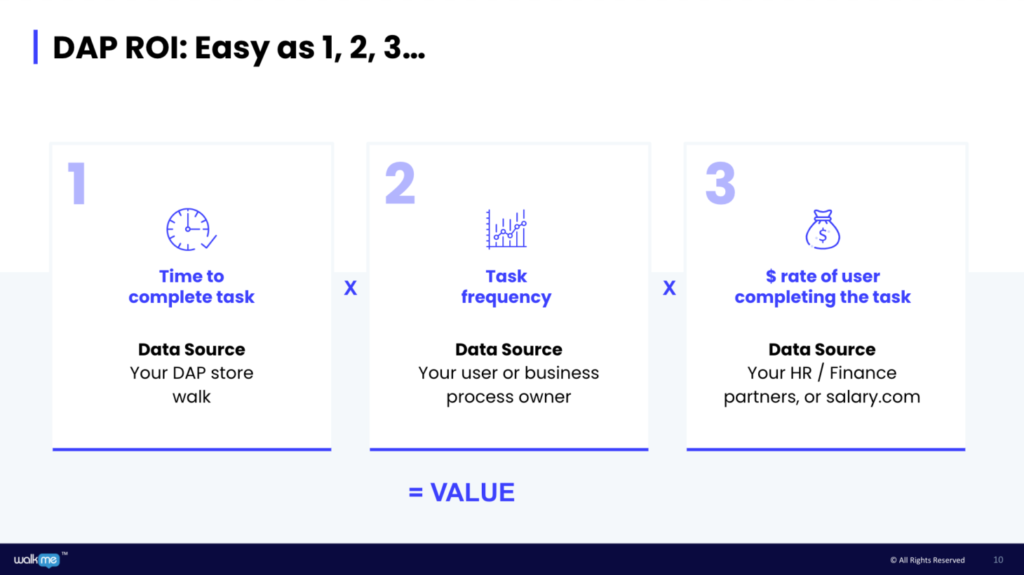
In step 3, you’ll do the fun part: calculate your DAP interventions’ impact!
To calculate your delta (also known as your DAP ROI), follow this formula:
(Time to complete a task)x (task frequency) x ($ rate of the user(s) completing the task) = ROI
I don’t recommend asking the user directly how much they earn. However, you may be able to get an idea by asking your internal HR department for an average or from job sites that list salary ranges by company (salary.com is a great resource for this).
And, remember, this is only the ROI for ONE user! You can now multiply your ROI number from the above equation by the total number of team members who complete the process. You’ll be amazed at how much impact one seemingly small DAP intervention can have on employee efficiency *and* dollar savings.
Step 4: Share your results with stakeholders.
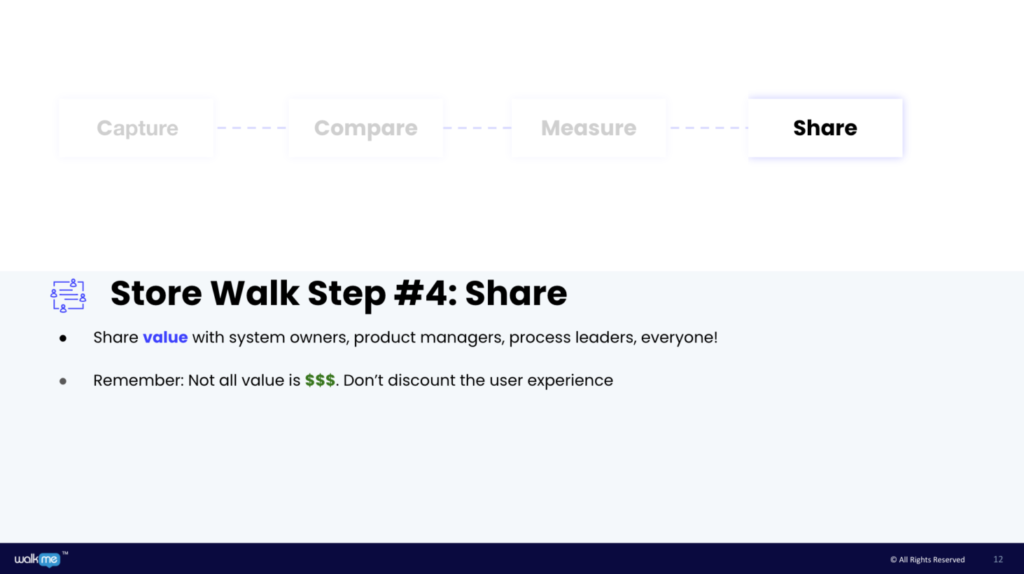
Since we’ve measured ROI, we’ve quantified value, and we’ve got cold, hard cash numbers to share with system users, stakeholders, and leaders to demonstrate the value of your WalkMe work. Share your success with EVERYONE!
Now, the only thing left to do is keep going and continuing this 4-step process for all your great DAP creations.
To keep in mind
Something important to remember: not all value is monetary. Don’t discount the value of user experience (those moments of frustration and joy that you document during your store walk process), but the calculation I’ve shared above gives you a simple framework to start understanding your digital adoption content’s impact.
Additionally, you’re very likely going to have a range of personas working with your systems. Those personas could possibly include a casual user, a specialist, or an expert – and it’s important to measure ROI accordingly. For example, casual users may be slower to complete a task, but since specialists complete the task more frequently, building DAP content to improve specialists’ experience may have a greater impact on ROI (compounding value).
In my DAP ROI Template, I’ve created a separate tab for each which you can use as your guide and I share an anecdote in my session recording.
Pro tips
I’ll leave with you a few additional best practices to keep in mind as you start implementing the store walk concept. These are things I’ve learned over the years as I’ve refined how I calculate, capture, and share value for DAP.
- Take seasonality into account
As you create your calculations, seasonality may become a factor. Ask yourself “Are people completing tasks at the same frequency throughout the year, or does it ebb and flow?” For example, in your HR system, you may see much greater levels of activity toward the end of the year during which many performance, benefits enrollment, and compensation tasks take place. If you calculate task frequency in June and December, you may see starkly different ROI results.
- Create user personas during your Store Walks
Segment your casual users, specialists, and experts to identify where you can make the most impact. I mentioned this above, but noting again here, because it’s important and enables you to focus on the areas that drive the most value for your company.
- Continue to update your baseline
After you make an improvement, you have a new baseline (the new time it takes people to complete a task) – and you can continue to use store walks to hone the experience and deliver more value! Remember that DAP content should never be static, but should always evolve and change based on your users’ experiences.
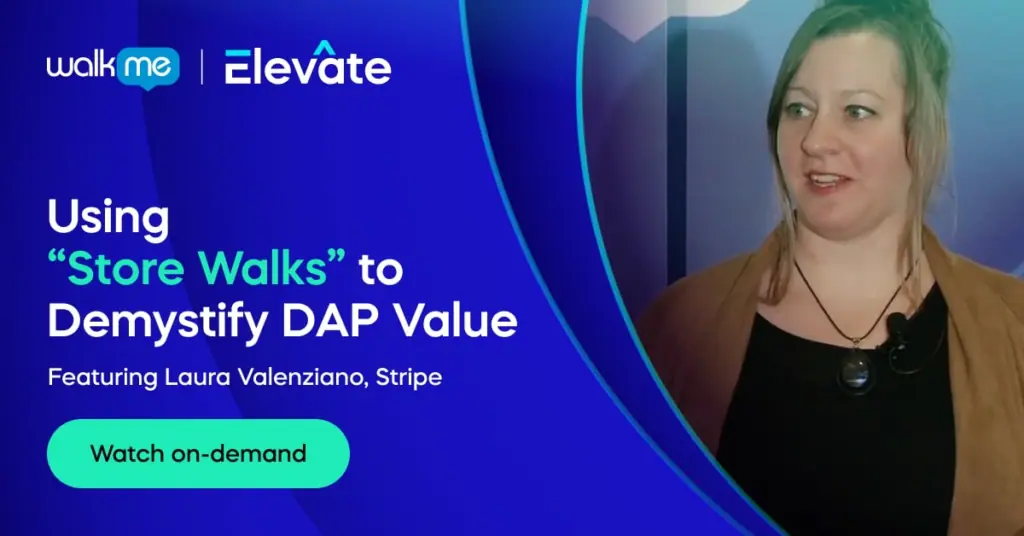
Conclusion
In summary, calculating our impact as DAP Professionals is critical – but it historically hasn’t been the easiest thing in the world. I hope that you find the store walk ROI calculation a relatively simple – yet impactful – way to capture the value you’re bringing to your users and your organization. Happy measuring!
Watch the Elevate breakout sessions on-demand.
See my session slides.

